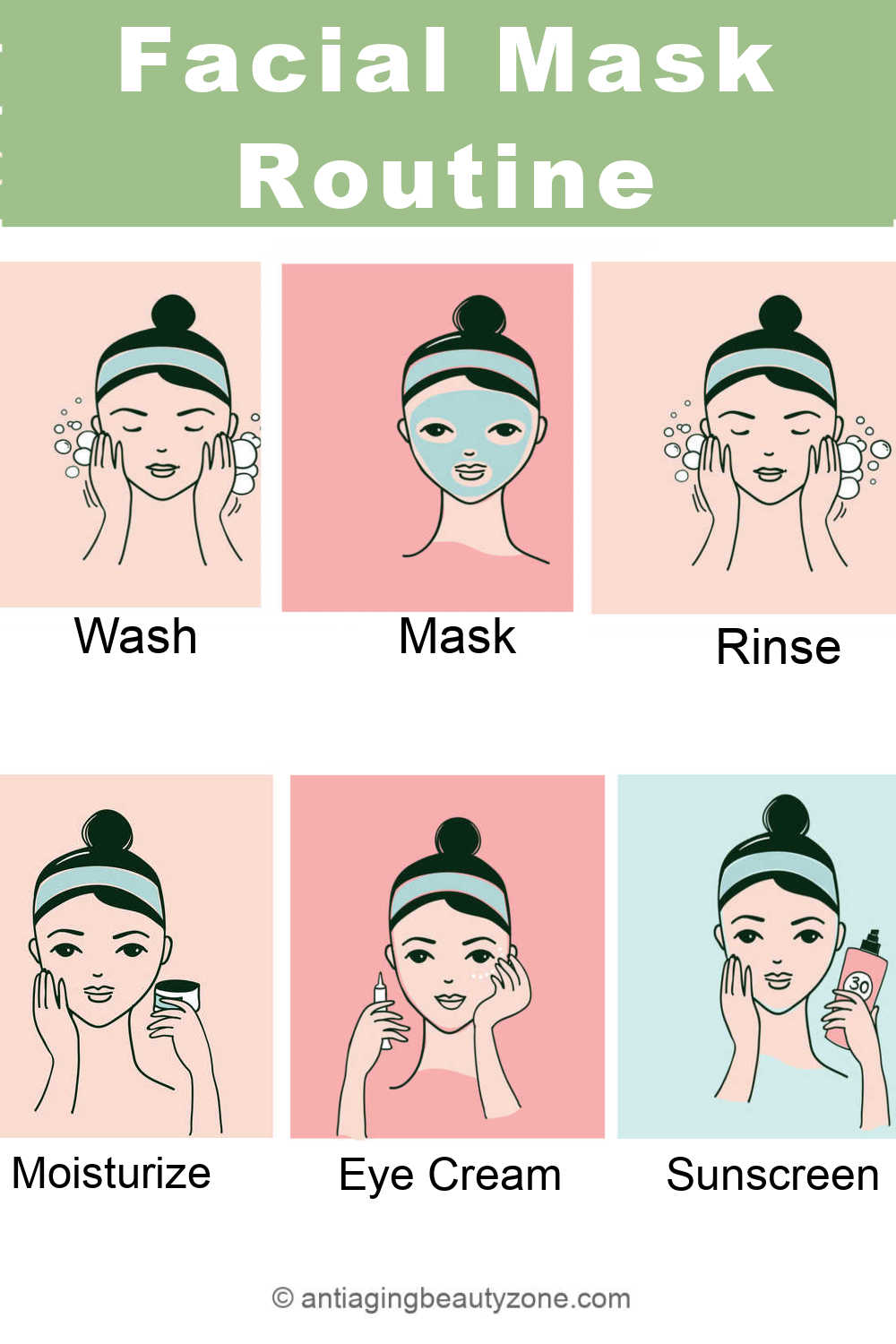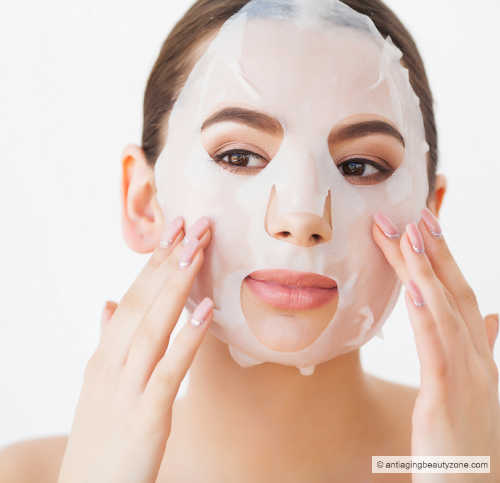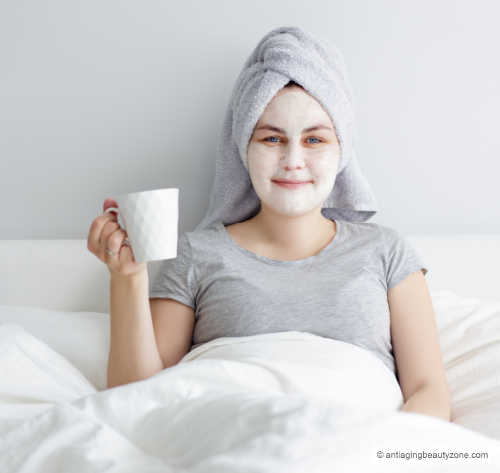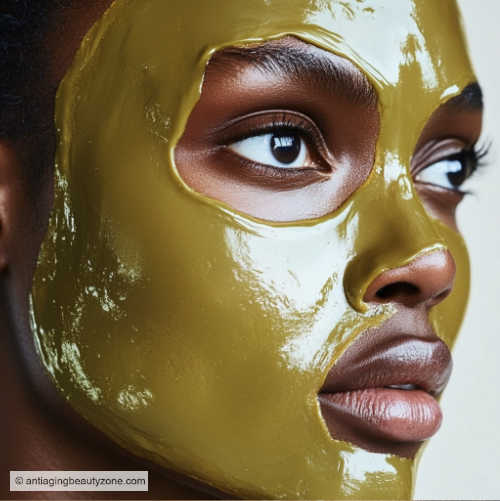As an Amazon Associate, I earn from qualifying purchases and other affiliate links. I only recommend products I’ve tried or researched.
- Home
- Skincare Guide
- Facial Masks
Different Types of Facial Masks for Glowing Skin: How to Choose the Right One for You
A Beauty Guide: Benefits of Sheet, Clay, Peel-Off, Gel, Overnight, DIY and Enzyme Skincare Masks
With so many facial masks out there—sheet, clay, gel, peel-off, and more—it’s easy to wonder which one actually helps your skin.
As a certified facial fitness specialist, I’ve tried nearly every type to see what really makes a difference for mature, changing skin. Some masks hydrate, others detoxify, and a few can even help support firmness and elasticity.

This guide breaks down the different types of facial masks, how they work, and which ones fit best in a natural skin-tightening routine.
You’ll also find a few DIY options at the end for when you want to mix up something quick at home.
Quick look: Face mask cheat sheet
Not sure which mask is right for your skin?
Here’s a quick chart showing what each type does and who it’s best for—then scroll down for detailed tips on how and when to use them.
| Face Mask Type | Key Benefits | Best For |
|---|---|---|
| Sheet Mask | Hydrates, brightens, soothes | Dry, dull, sensitive skin |
| Clay Mask | Absorbs oil, cleans pores, helps reduce breakouts | Oily & acne-prone skin |
| Gel Mask | Cools, soothes & deeply hydrates | Sensitive & inflamed skin |
| Peel-Off Mask | Exfoliates, removes dead skin | Dull or combination skin |
| Enzyme Mask | Gently exfoliates, improves glow, softens skin | Aging & sun-damaged skin |
| Overnight Mask | Deeply nourishes, repairs, locks in moisture | Dry, aging, or mature skin |
| DIY Mask | Customizable: hydrate, exfoliate, or soothe | All skin types (varies by ingredients) |
ABZ Tip: For combination skin, try multi-masking—use a clay mask on oily areas (like the T-zone) and a hydrating mask on dry spots like cheeks.
Now that you’ve seen a quick overview, let’s look at why face masks are so effective—and how each one helps your skin look firmer, smoother, and more radiant.
Benefits of using a face mask
Facial masks aren’t just a luxury—they’re one of the easiest ways to refresh and nourish your skin.
Top Benefits:
- Boosts Hydration – Sheet and gel masks deeply moisturize and plump.
- Unclogs Pores & Absorbs Oil – Clay and peel-off masks absorb oil and debris.
- Exfoliates Dead Skin Cells – Enzyme and peel-off masks smooth dull skin.
- Brightens & Evens Out Skin Tone – Masks with vitamin C, pearl powder, or fruit enzymes reduce dullness.
- Delivers Powerful Ingredients – Unlike creams, masks stay on longer, allowing deeper penetration.
- Improves Product Absorption: Prepping skin with a mask helps serums and moisturizers work better.
Used regularly, masks keep your complexion balanced and give tired skin an instant boost.
How face masks work
Face masks act as skin boosters. They stay on longer than creams, creating a barrier that locks in ingredients so they penetrate more deeply.
When to use a face mask in your skin care routine
Not sure when or how often to mask? Use this quick-reference chart to plan your weekly routine.
Note: Turn phone sideways to view chart.
| Mask | When to Use | Freq. | Best Applied |
|---|---|---|---|
| Sheet | AM or before special events | 1–4× weekly, as needed | After cleansing, before moisturizer |
| Gel | AM or anytime skin needs soothing | 1–3× weekly | After cleansing, before moisturizer |
| Clay | PM | 1–2× weekly | After cleansing, before moisturizer |
| Peel-off | PM | 1× weekly | After cleansing, before moisturizer |
| Enzyme | PM | 1× weekly | After cleansing, before moisturizer |
| Overnight | PM (or overnight) | 2–4× weekly | Last step in evening routine |
| DIY | AM or PM | 1–2× weekly | After cleansing, before moisturizer |
ABZ Tip: Morning masks hydrate and prep the skin for makeup, while evening masks detoxify and renew. Most masks work best 1–3 times a week, depending on your skin’s needs.
How to use facial masks (a simple 3-step routine)
Here’s what a simple mask routine looks like:
Cleanse, apply your mask, rinse, moisturize, and SPF—easy as that! This quick visual helps you see how every mask fits into your skincare rhythm.

Now that you’ve got the basic routine down, let’s look at what makes each type of mask unique and when to use it.
Top 7 popular types of facial masks
Let's dive into 7 different types of skincare face masks:
- Sheet
- Overnight
- Gel
- Clay
- Peel-off
- DIY At-home
- Enzyme masks
General Application
Here's a routine for 7 common masks, listed from the gentlest to the most intense. Adjust frequency based on your skin's needs and mask type.
1. Sheet

This one-time use, paper mask is pre-soaked in serums to hydrate and brighten. They’re great for a quick moisture boost and a dewy glow.
Use 4-7 times a week after cleansing and before treatments. They can replace or be use along with serums and moisturizers, for extra hydration as needed.
Important Note: Some sheet masks may contain AHA or BHA. If so, follow the label's usage instructions carefully. These acids exfoliate and increase sun sensitivity, so use with caution to avoid irritation or damage
2. Overnight

Cream-based overnight masks deeply hydrate and repair your complexion while you sleep, helping to improve texture and reduce dryness. Just be prepared for some sticky pillowcases. Consider placing a towel over your pillows on mask nights!
Use 3-4 times a week as the last step in your evening routine. Apply after cleansing and any treatments. Leave it on overnight for deep hydration and repair.
3. Gel

Light gel cooling masks soothe and hydrate the skin, often used to calm irritation or redness and provide a refreshing boost.
Use 1-3 times a week. Apply after cleansing and before moisturizers and treatments.
4. Clay

Clay masks come in various colors like green, grey, or brown. These thick, mud-like masks absorb excess oil and draw out impurities, making them perfect for deep cleansing and controlling shine, especially for oily or combination skin.
Use 1-2 times a week. Apply after cleansing and before moisturizers and treatments. Ideal for days when your skin feels congested or oily. Or only use on T- Zone/problem areas.
5. Peel-off

Peel-off masks start as a thick gel that dries and can be peeled or rubbed off. They help remove dead cells and unclog pores. Use them cautiously if you have sensitive skin, as they can be drying.
Use once a week after cleansing and before applying other treatments.
6. DIY
DIY at-home masks/scrubs let you customize using ingredients like fruits and honey. Some scrubs also double as masks, offering exfoliation and treatment all-in one.
ABZ Tip: Gentle exfoliation is a must for glowing, healthy skin—especially after 40!
Sugar-based scrubs offer dual benefits: let the scrub sit for a few minutes to break down dead cells, then scrub gently for extra exfoliation before rinsing.
Check out these easy sugar scrub and exotic Korean scrub recipes!
Use 1-2 times week, after cleansing and before moisturizers and treatments. Do not leave on longer than 15 minutes. Always patch-test first.
7. Enzyme

Enzyme masks come in two types:
DIY at-home masks, which can vary in strength, and store-bought formulas that offer more predictable results.
If natural masks are your thing, see how enzyme facials work—and try my DIY recipes.
Enzymes can gently exfoliate and brighten the skin. But be careful not to over-exfoliate. Use once a week after cleansing and before applying organic or ceramide-rich moisturizers.
Bonus: DIY Masks you'll want to try!
These glow-boosting recipes are easy to make and backed by time-tested ingredients. Whether you’re targeting breakouts, dullness, or dryness—these are my go-to homemade face masks from my Homemade Skincare Recipes & Beauty Hacks collection:
- Pearl Powder Mask – Boosts glow and firmness. I mix it with honey or yogurt when my skin looks dull.
- Turmeric Scrub-Mask – A multitasker that brightens and hydrates.
- Oily Skin Mask – Balances oil and calms inflammation with gentle natural ingredients.
You’ll find the full recipes and variations in my Homemade Skincare Recipes guide.
How to choose
If your skin’s pretty balanced, you can use a variety of masks and rotate them through the week. But if you deal with dryness, oiliness, or sensitivity, it’s best to pick masks that target those specific concerns.
Building a face mask routine that fits your skin helps you get better results—whether that’s extra hydration, calming redness, or keeping oil under control.
ABZ Tip: Not sure if you’re making a masking mistake? Check out my list of common face mask mistakes to avoid.
Match your mask to your skin type
Match your mask to your skin type:
- Oily, clogged pores, or acne-prone: Clay or charcoal masks absorb oil and unclog pores. Try this oil-absorbing homemade mask.
- Dry, aging, or sensitive: Sheet, overnight, or honey-based masks provide moisture without irritation.
- Combination: Try multi-masking—use clay on your T-zone and a cream mask on drier areas.
- Brightening: Look for vitamin C, niacinamide, pearl powder, or fruit enzymes like papaya.
- Signs of aging: Seek ingredients like AHA, retinol, ceramides, or peptides.
- Redness or inflammation: Gel and sheet masks with aloe or green tea help calm the skin.
Adjusting your routine
Don’t be afraid to mix it up. Your skin’s needs change with seasons, stress, or hormones—so stay flexible and adjust your masking choices accordingly.
Finding the right combination may take a little trial and error. Start with weekly use and see how your skin responds. With patience, you’ll discover what works best for you.
ABZ Tip: Always patch-test new products, especially if your skin tends to be sensitive.
Takeaway:
Face masks are one of the easiest ways to refresh and nourish your skin. From the instant hydration of sheet masks to the deep cleansing power of clay, each one offers unique benefits.
Now that you know what each type does, which one will you try first? Whether you’re after glow, moisture, or a little lift, the right mask can transform your skincare routine.
Want More?
I share quick routines, beauty tweaks, and what’s working for me — straight to your inbox. Join the Club and get this free Cheek Shaper Video.
About the Author:
Linda Robison is a Facial Fitness Specialist and the founder of Anti-Aging Beauty Zone. With decades of hands-on experience, she shares practical, natural ways to lift and brighten mature skin—without expensive or invasive treatments.
Before you go ....
Please tap on the💙in the bottom right corner if you found this page helpful.
FOLLOW ME FOR MORE TIPS:
SHARE OR SAVE FOR LATER:





